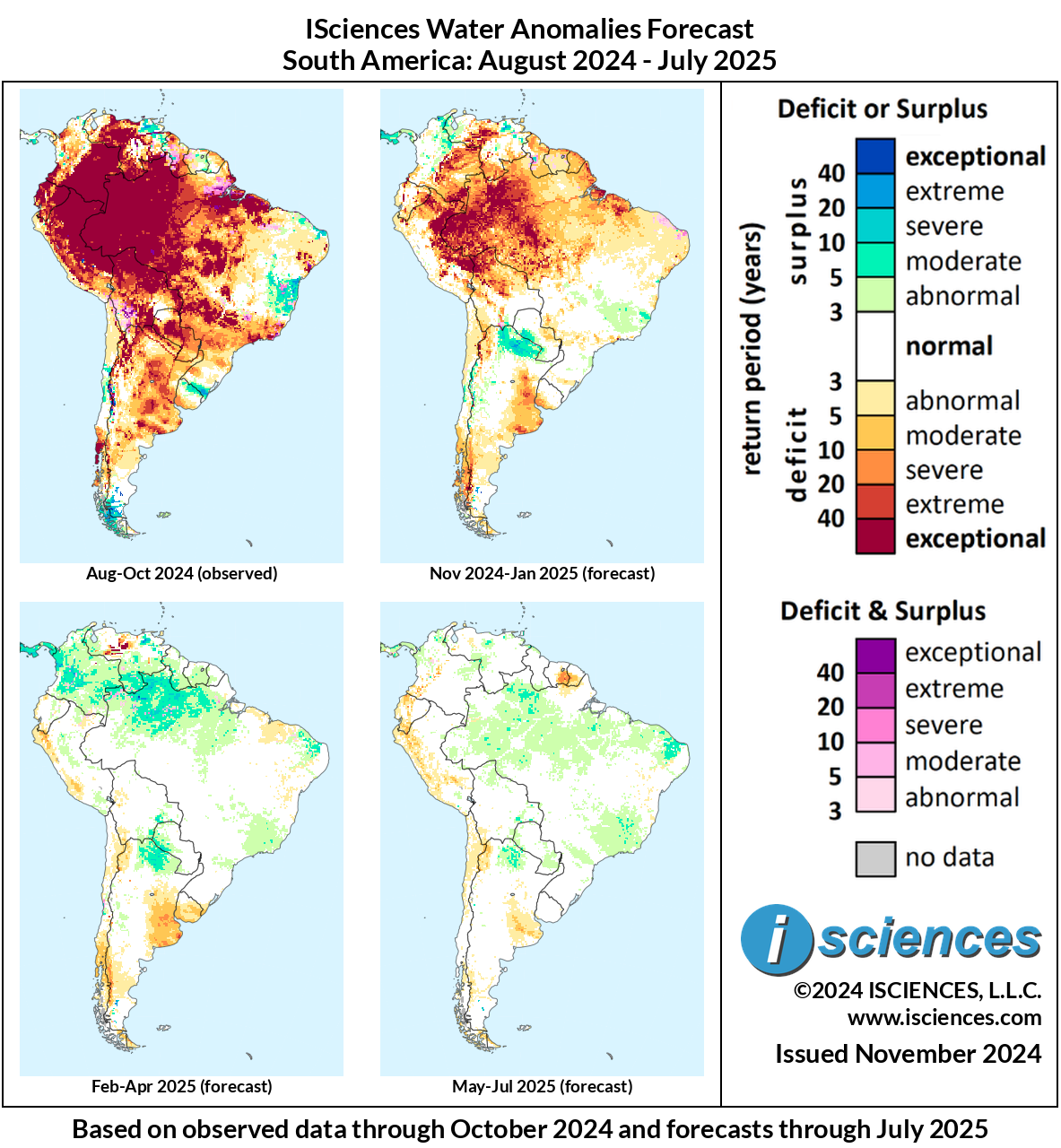South America: Amazon, Bolivarian Nations to observe continued deficits
22 September 2024
THE BIG PICTURE
The forecast for the 12-month period ending in July 2025 indicates that exceptional deficits will remain throughout the Amazon and the Bolivarian Nations. Similar deficits will occur in northeastern coastal regions of Brazil, in Argentina, and in Chile.
Severe to exceptional deficits are anticipated in:
Western Brazil, widespread throughout the states of Amazonas, Acre, and Rodonia. These deficits continue into the majority of central and eastern Peru, as well as along western coastal regions of the country.
Northern Brazil, in coastal regions of the states of Amapá and Para.
Northern Bolivia, in northern areas of the Beni Department and the Manuripi National Amazon Wildlife Reserve. Isolated pockets of central to northeastern Colombia will experience similar deficits, as well as areas of western Venezuela.
Northwestern, eastern, and southern Argentina, throughout much of the Salar de Antofalla, as well as the Santa Cruz, Chubut, and Buenos Aires provinces.
Moderate to severe surpluses are anticipated in:
Northern Argentina, primarily in the Salta and Jujuy provinces.
Eastern Venezuela, near the Guri Reservoir.
The 3-month maps (below) show the evolving conditions in more detail.
FORECAST BREAKDOWN
The forecast through January 2025 indicates that exceptional deficits will persist in the Amazon and in much of Peru. These deficits are also expected to linger in central to northeastern Colombia, central Venezuela, and northeastern Bolivia. Coastal regions of the Brazilian state of Amapa will also persist. Further south, southern areas of Chile will experience deficits of severe to exceptional intensity, while the Buenos Aires province of Argentina will observe moderate to severe deficits. Northern Argentina can expect moderate surpluses to emerge.
From February through April 2025, exceptional deficits throughout the Amazon are expected to dissipate. Moderate to severe surpluses are expected to emerge in northern portions of the Brazilian states of Amazonas and Roraima. These surpluses are expected to also appear in southwestern Colombia and northernmost regions of Argentina. Exceptional deficits are anticipated in central and west-central Venezuela. Moderate to severe deficits are expected in southern Chile and eastern Argentina.
The forecast for the final months – May through July 2025 – expects near-normal conditions and abnormal surpluses to appear in most of Brazil and bordering countries. Moderate to severe deficits may appear in Suriname and French Guiana. Abnormal deficits may continue along South America’s western coast, as well as in the Buenos Aires province of Argentina.
Please note that WSIM forecast skill declines with longer lead times.
IMPACTS
As the Amazon experiences two years of record-breaking drought, fisheries in the Amazonas have reported a significant drop in the pirarucu population. This decrease is expected to affect the sustainability of the pirarucu-fishing economy. Last year, the total catch totaled 70% of the government-authorized quota of 100,443 fish. This year is expected to see an even more drastic decrease. Unlike other aquatic species of the Amazon, the pirarucu, have historically proven resilience to drought and climate change, but low water levels are making it extremely difficult for fishers to transport their catch from remote lakes to major rivers and onto cities.
Over 420,000 children across Brazil, Colombia, and Peru have been affected by the current record-breaking drought. As river levels continue to decline, access to food, water, medical supplies, and other essential services such as transportation and access to education continues to dwindle. “For centuries the Amazon has been home to precious natural resources. We are witnessing the devastation of an essential ecosystem that families rely on, leaving many children without access to adequate food, water, health care and schools,” said UNICEF Executive Director Catherine Russell. “We must mitigate the effects of extreme climate crises to protect children today and future generations. The health of the Amazon affects the health of us all.”
In the Peruvian city of Piura, lack of rainfall has stifled production of several crops, including limes, yucca, corn, papaya, tomatoes, and peppers. As reservoirs become depleted, the regional authorities prompted the government to declare a state of emergency and assist local farmers. Local growers stated that the drought has affected the quality of the limes, which limit them to only being sold on the domestic market. “It is very likely that, due to the drought, the lemon market will not recover from this negative percentage between now and December. The report we have is that the amount of water for productive and exporting valleys is reaching minimum levels,” said Gabriel Amaro, president of the Association of Agricultural Producer Guilds of Peru. Amaro also noted that the 2025 crop is also likely to be affected, which could lead to higher prices.
NOTE ON ADMINISTRATIVE BOUNDARIES
There are numerous regions around the world where country borders are contested. ISciences depicts country boundaries on these maps solely to provide some geographic context. The boundaries are nominal, not legal, descriptions of each entity. The use of these boundaries does not imply any judgement on the legal status of any territory, or any endorsement or acceptance of disputed boundaries on the part of ISciences or our data providers.
Subscribe to our monthly Water Watch List
Search blog categories
- *Precip/Temp Outlooks 101
- *Press Releases 1
- *Special Topics 19
- *Water Watch Lists 118
- Africa 128
- Australia & New Zealand 112
- Canada 114
- Central Asia & Russia 112
- East Asia 113
- Europe 119
- Mexico & C. Amer. & Carib 117
- Middle East 122
- Proof Point 1
- South America 127
- South Asia 118
- Southeast Asia & Pacific 121
- United States 118
Search blog tags


